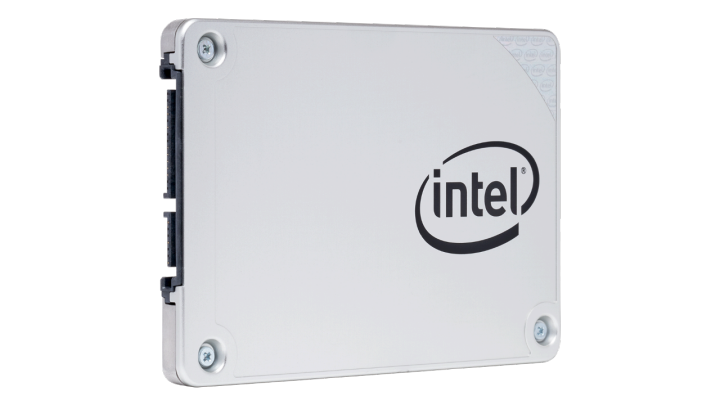Intel Announces TLC-Based 540s, 5400s SSDs
"Expect More. Do More." Intel's new SSD 540s and SSD Pro 5400s Series comes with several catchy one-liners, but the joke is on us. The two new SSD products announced for the consumer and business client markets mark Intel's first foray into the world of three-bit-per-cell (TLC) NAND flash. Intel did not leap with Micron to build 16nm flash, a move that would have guaranteed the company in-house 16nm TLC. Instead, Intel chose to skip the node entirely, leaving Micron to foot the bill. This also left Intel, a company with NAND flash manufacturing capabilities, as a customer of SK Hynix for this product cycle. We suspect Intel expected new 256Gbit die 3D flash memory to come sooner than it has from its joint venture with Micron, IMFT.
The Next Level of Consumer Computing
| Header Cell - Column 0 | 120 GB | 180 GB | 240 GB | 360 GB | 480 GB | 1000 GB |
|---|---|---|---|---|---|---|
| Raw Capacity | 128 GB | 192 GB | 256 GB | 384 GB | 512 GB | 1,024 GB |
| Form Factors | 2.5 InchM.2 2280 | 2.5 InchM.2 2280 | 2.5 InchM.2 2280 | 2.5 InchM.2 2280 | 2.5 InchM.2 2280 | 2.5 InchM.2 2280 |
| Interface | SATA 6 Gbps | SATA 6 Gbps | SATA 6 Gbps | SATA 6 Gbps | SATA 6 Gbps | SATA 6 Gbps |
| Sequential Read | 550 MB/s | 560 MB/s | 560 MB/s | 560 MB/s | 560 MB/s | 560 MB/s |
| Sequential Write (Burst) | Up To 480 MB/s | Up To 480 MB/s | Up To 480 MB/s | Up To 480 MB/s | Up To 480 MB/s | Up To 480 MB/s |
| Sequential Write (Sustained) | 70 MB/s | 90 MB/s | 100 MB/s | 100 MB/s | 125 MB/s | 125 MB/s |
We're surprised Intel chose to bring these new products to market under the 5-Series banner. When we first heard rumors that Intel signed with Silicon Motion for controllers over two years ago, we expected the company to utilize the 4-channel SM2246EN with MLC flash and release another entry-level product. That would have fallen under the 300-Series label, one the company hasn't updated since 2012 (SSD 335). The two new products announced today are actually slower than the SSD 335 Series from 2012 in many key categories, including sustained writes. They also employ Silicon Motion's newest controller designed for TLC flash, the SM2256 (read our preview here).
As far as we can tell from the information we have on hand today, the 540s (consumer) and 5400s (business client) products differ only in Intel's vPro capabilities. The 5400s business client-class products support remote management with Intel's vPro and AMT technologies. This allows system administrators to remotely erase the data on the drive with Intel's Remote Secure Erase software. The 540s does not have these business-focused features.
Both products include a standard 5-year warranty and support AES 256-bit hardware encryption. The two series ship in both 2.5-inch and M.2 2280 form factors. The largest-capacity M.2 drive (1 TB) uses a double-sided configuration for the surface mount components, but the smaller capacity sizes use a single-sided design that is supported by more notebooks and Ultrabooks.
The new consumer and business client SSDs replace aging products in the Intel product lineup with SandForce SF-2281 controllers and SK Hynix 20nm MLC flash. Intel didn't release any pricing details, but we suspect the new drives will cost less than the SSD 535 and Pro 2500 series. The 5-year warranty will be an advantage to similarly configured products like the Adata SP550 (our review here).
Get Tom's Hardware's best news and in-depth reviews, straight to your inbox.

Chris Ramseyer was a senior contributing editor for Tom's Hardware. He tested and reviewed consumer storage.
-
Lutfij Intel's products with underlying SK Hynix parts seems like a recipe for success. If only Intel employed a team for their aesthetics and design elements I think it'd have garnered more followers.Reply -
alextheblue The warranty is a big plus in my book. I'll be interested to see how it fares against my current favorite affordable SSD, the 850 Evo.Reply -
photonboy Sustained WRITES is pretty low though.Reply
I get around 500MB/second with my Samsung drives (by copying a movie between two SSD's). I timed it. -
hitman400 ReplyIntel's products with underlying SK Hynix parts seems like a recipe for success. If only Intel employed a team for their aesthetics and design elements I think it'd have garnered more followers.
Do parts really need design if they are interior components? I can understand if you are a PC builder and have a case window. -
bikerepairman1 ReplyDo parts really need design if they are interior components? I can understand if you are a PC builder and have a case window.
Even then the drive is in a cage and only shows the cables or the other small side. Also design makes the drive more expensive.
-
littleleo These drives will probably sell and sell well because of 5 letters I N T E L. Whether they are better than the competition's current models or not.Reply -
firefoxx04 I would be happy with a sustained speed above 250 but less than 150 is pretty bad.. I guess the iop and read performance will still make the system fast.Reply
